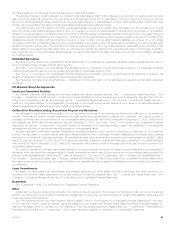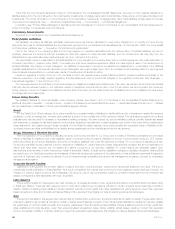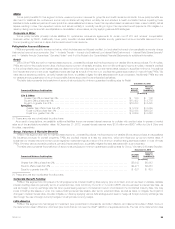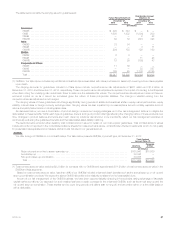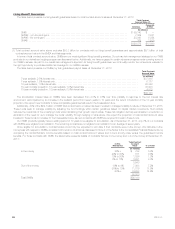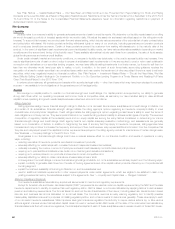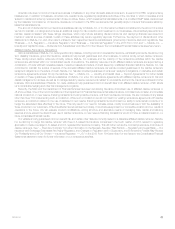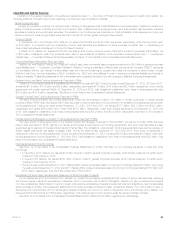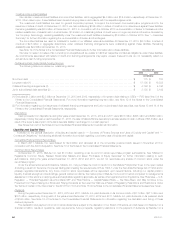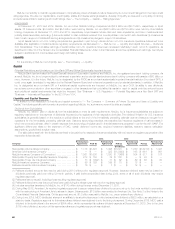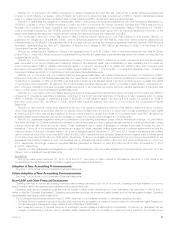MetLife 2013 Annual Report Download - page 69
Download and view the complete annual report
Please find page 69 of the 2013 MetLife annual report below. You can navigate through the pages in the report by either clicking on the pages listed below, or by using the keyword search tool below to find specific information within the annual report.
American Life does not conduct insurance business in Delaware or any other domestic state and, as such, is exempt from RBC requirements by
Delaware law. In addition to Delaware, American Life operations are regulated by applicable authorities of the countries in which it operates and is
subject to capital and solvency requirements in those countries. Exeter, which prepares financial statements on a modified GAAP basis, as approved
by the Delaware Commissioner of Insurance, likewise is not subject to the RBC requirements that generally apply to insurers that prepare statutory-
basis financial statements.
The amount of dividends that our insurance subsidiaries can pay to MetLife, Inc. or to other parent entities is constrained by the amount of surplus
we hold to maintain our ratings and provides an additional margin for risk protection and investment in our businesses. We proactively take actions to
maintain capital consistent with these ratings objectives, which may include adjusting dividend amounts and deploying financial resources from
internal or external sources of capital. Certain of these activities may require regulatory approval. Furthermore, the payment of dividends and other
distributions to MetLife, Inc. and other parent entities by their respective insurance subsidiaries is governed by insurance laws and regulations. See
“Business — U.S. Regulation — Insurance Regulation,” and “Business — International Regulation” in the 2013 Form 10-K and “— MetLife, Inc. —
Liquidity and Capital Sources — Dividends from Subsidiaries” and Note 16 of the Notes to the Consolidated Financial Statements elsewhere herein.
Affiliated Captive Reinsurance Transactions
Various subsidiaries of MetLife, Inc. cede specific policy classes, including term and universal life insurance, participating whole life insurance, long
term disability insurance, group life insurance, variable annuity benefit guarantees and other business, to various wholly-owned captive reinsurers.
These wholly-owned captive reinsurers primarily reinsure MetLife, Inc. business and the majority of the reinsurance activities within the captive
reinsurers are eliminated within our consolidated results of operations. The statutory reserves of such affiliated captive reinsurers are supported by a
combination of funds withheld receivable assets, investment assets and letters of credit issued by unaffiliated financial institutions. MetLife, Inc. has
committed to maintain the surplus of several of the domestic affiliated captive reinsurers, as well as provided guarantees of the captive reinsurers’
repayment obligations on the letters of credit. MetLife, Inc. has also provided guarantees of reinsurers’ repayment obligations on derivative and certain
reinsurance agreements entered into by the captives. See “— MetLife, Inc. — Liquidity and Capital Uses — Support Agreements” for further details
on certain of these guarantees. Various subsidiaries of MetLife, Inc. enter into reinsurance agreements with affiliated captive reinsurers for risk and
capital management purposes, as well as to manage statutory reserve requirements related to universal life and term life insurance policies and other
business. Various subsidiaries of MetLife, Inc. cede variable annuity guaranteed minimum benefit risks to an affiliated captive reinsurer, which allows
us to consolidate hedging and other risk management programs.
Recently, the NAIC and the Department of Financial Services have been scrutinizing insurance companies’ use of affiliated captive reinsurers or
off-shore entities. One of the recommendations of the Department of Financial Services is that state insurance commissioners consider an immediate
national moratorium on new reserve financing transactions involving captive insurers, until their inquiries are complete. We are not aware of any states
other than New York implementing such a moratorium. While such a moratorium would not impact our existing reinsurance agreements with captive
reinsurers, a moratorium placed on the use of captives for new reserve financing transactions could impact our ability to write certain products or to
hedge the associated risks effectively in the future. This may result in our need to increase prices, modify product features or limit the availabilityof
those products to our customers. While this affects insurers across the industry, it could adversely impact our competitive position and our results of
operations in the future. We will evaluate product modifications, pricing structure and alternative means of managing risks, capital and statutory
reserves and we expect the discontinued use of captive reinsurance on new reserve financing transactions would not have a material impact on our
future consolidated financial results.
Our variable annuity guaranteed minimum benefit risk and certain other risks are currently ceded to a Delaware affiliated captive reinsurer. MetLife,
Inc. is planning to merge this captive reinsurer with three U.S.-based life insurance companies in the fourth quarter of 2014, subject to regulatory
approvals, to create one larger U.S.-based and U.S. regulated life insurance company. This will further reduce the Company’s exposure to and use of
captive reinsurers. See “— Executive Summary” for further information on the Mergers. See also “Risk Factors — Regulatory and Legal Risks — Our
Insurance and Brokerage Businesses Are Highly Regulated, and Changes in Regulation and in Supervisory and Enforcement Policies May Reduce
Our Profitability and Limit Our Growth — Insurance Regulation — U.S.” in the 2013 Form 10-K and Note 6 of the Notes to the Consolidated Financial
Statements elsewhere herein for further information on our reinsurance activities.
MetLife, Inc. 61




